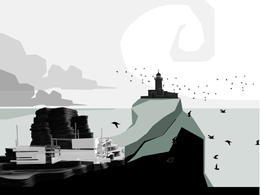STUDENTS PROJECTS
PROJECTS2015

29 July, 2015
Walking By Medea
The spatial transmission of the ancient greek myth of Medea at the Cape Melangavi.
Student : Dimitra Michopoulou
Supervisor : Helen Tatla
ATEI of Athens | Department : Interior Architecture, Decoration and Product Design
Presentatιon date : 05 /2015
In this study, are examined the importance of movement and route and how these two, essentially, manipulate the perception of the landscape of any observer.
The inspiration, on which this study is articulated, is the tragic myth of Medea, that becomes the vessel of an experiential travel of the visitor, aiming the understanding of the genious loci of Melagavi Cape.

The myth, as part of the history and essence of the place, is an interference in the scenery and a condition of integration on it. In this light, the very movement of a human's look in the venue and the friction with the myth, as it is interpreted spatially, acquires an architectural dimension, since it forms a specific way of perceiving the venue.
This movement, leaves its traces on the venue, by being an element of "elementary architecture". On the other hand, almost all architectural deeds, are articulated on a movement.

With the myth as instrument and the scenographic aspect of the venue, the visitor is introduced to an alternate "play" in which one is both the actor and the audience. One is required to tend to the social and moral dilemmas that stem from the timeless meaning of Medea's myth and to understand oneself through participation, struggle and movement with the scenery, ultimately reaching absolution.

The suggested route is formed by the lingering spatial traces led by Medea's myth, traces of betrayal, pathos, death. The traveler becomes a waif in the myth's whirlpool and is introduced to a world forcing confrontation with oneself and one's emotions, each time one spots a key point in this unusual journey. The axis of the route, on which the myth of Medea is carried spatially, is formed and based on the importance of the ancient Greek meaning of tragedy, on the mental anguish and the need for absolution.
The myth is dissected in praxis-scenes, which, each one, belong respectively to a construction- prop. This way, the observer is able to understand the development of the myth's plot and to reach deeper into the emotional changes one experiences through experiential contact with the "set". The form of the constructions and its meaning, the materials of which the props are made, the deliberate use of light and shadow, of the vacant and the full, brings about emotional charging, stemming from every on stage form towards the visitor, a reference to his optical imprint. The feeling of loss and mental breakdown, as a result of the ideals and ethical barriers demolition, is interpreted through the use of "scaffolding". Scaffolding, while it is used as support to the aid of the construction of a new building, it is at the same time a temporary constructιon from materials susceptible to damage, much like wood and oxidized metal. Each piece-set of the journey, interprets spatially the emotional-psychosomatic condition of Medea, sympathizing and travelling along with the myth until it reaches absolution.












